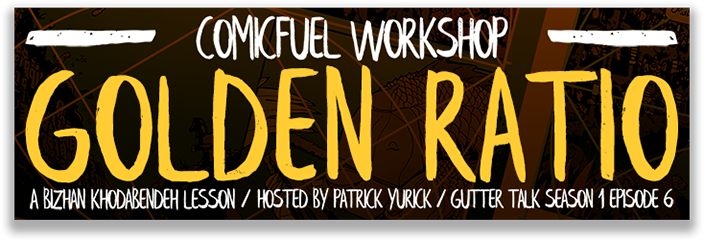Okay, you paid lots of dough to have a table at a con because you want your work to be noticed. But having a table doesn’t mean each registered attendee is going to automatically walk up. Sorry, but the real world “stumble upon” isn’t as efficient. Now, you’ve got to get the convention goers’ attention. And the best way of doing this is offering your free item. (I will go in depth in another post on free item ideas.) (more…)
Posts Tagged: creating
Panel Layout: The Golden Ratio
Announcing our FREE Golden Ratio Workshop designed to expand on the concepts introduced in the article below!

Excitement would understate how I felt when I read Frank Santoro’s articles on the first appearance of the Golden Ratio in Hergé’s TIntin comic pages. Santoro used grid overlays to explain comic composition with geometric shapes in a way that could be easily understood by a graphic designer, like myself. (more…)
You Have a New Idea! So What?
No one ever says to the surgeon, “You know, I think I’d really like to try performing a kidney transplant sometime.” Meanwhile, there is no professional or aspiring professional writer who has not heard, at least once, upon explaining his or her vocation, “You know, I think I’ve got a novel in me, somewhere.” It’s infuriating. (more…)
Nondestructive Photoshop Shadows and Effects
Efficiency. As comic creators, we’re all striving for it. With full-time jobs, family, and everything else life throws at us competing for our precious art time, being more efficient means getting more done. My goal with these Photoshop articles is to help you streamline your process to get more work done in the same amount of time – or even less. I began with an article on using Photoshop Actions in your workflow. Today, I want to talk about using some of the more powerful features of a world class application like Photoshop. Specifically, creating shadows and effects nondestructively. But what is nondestructive editing? Let’s have Adobe explain it:
Nondestructive editing allows you to make changes to an image without overwriting the original image data, which remains available in case you want to revert to it. Because nondestructive editing doesn’t remove data from an image, the image quality doesn’t degrade when you make edits.
How To Use Photoshop Actions To Speed Up Your Comic Work
If you use Adobe Photoshop at any point in your comics making process, then there’s a good chance you should be using Actions to speed up your process. But what are Actions, and why would you want to use them? (more…)
Hand Lettering A Digital Comic, Part 3
Once you have your lines of text set out, it’s time to launch into the final stage of lettering a page: composing your text on the page, and this is where I think hand-lettering shows a great advantage over font or mechanical lettering: flexibility.
Creativity
The most common question that creative people get asked by “normal” people may well be, “Where do you get your ideas?” It’s a difficult question to answer, because it assumes there is an easy answer, some kind of tangible oasis that transforms visitors into brilliant artists. In my experience, ideas for comics (and other art forms) aren’t found in one place, but in EVERY place. And if one wants to be a creator, then one should constantly be seeking out new experiences in life and art alike, actively seeking inspiration instead of expecting it to arrive.
[Tweet “Ideas for comics aren’t found in one place, but in EVERY place.”]
Drafting Work Towards Completion
One of the central truisms of being an artist is this:
You will have to do many drafts of your work.
It’s unavoidable. There is this myth among artists about how the masters of the craft were gifted from the beginning — that they went into their studios and produced works of greatness in a matter of hours. This is exacerbated by videos like this one, where it’s possible to watch a master like John Romita Sr. as he quickly busts out perfect drawings of Spider-man with a felt tip marker. Amazing, right? And deservedly so! John Romita Sr. has created comics since 1949 and has been drawing Spider-man since 1966. He’s had a lifetime of practice in order to reach a place where he can draw something amazing with minimal revisions. (more…)
Get Started Already!
3: Patrick Yurick & Adam Greenfield – MakingComics.com Gutter Talk Podcast
Adam sits down with Patrick Yurick to discuss what to do when comic inspiration strikes.
Podcast: Play in new window | Download (Duration: 35:14 — 48.4MB) | Embed
Subscribe: Apple Podcasts | Email | RSS









